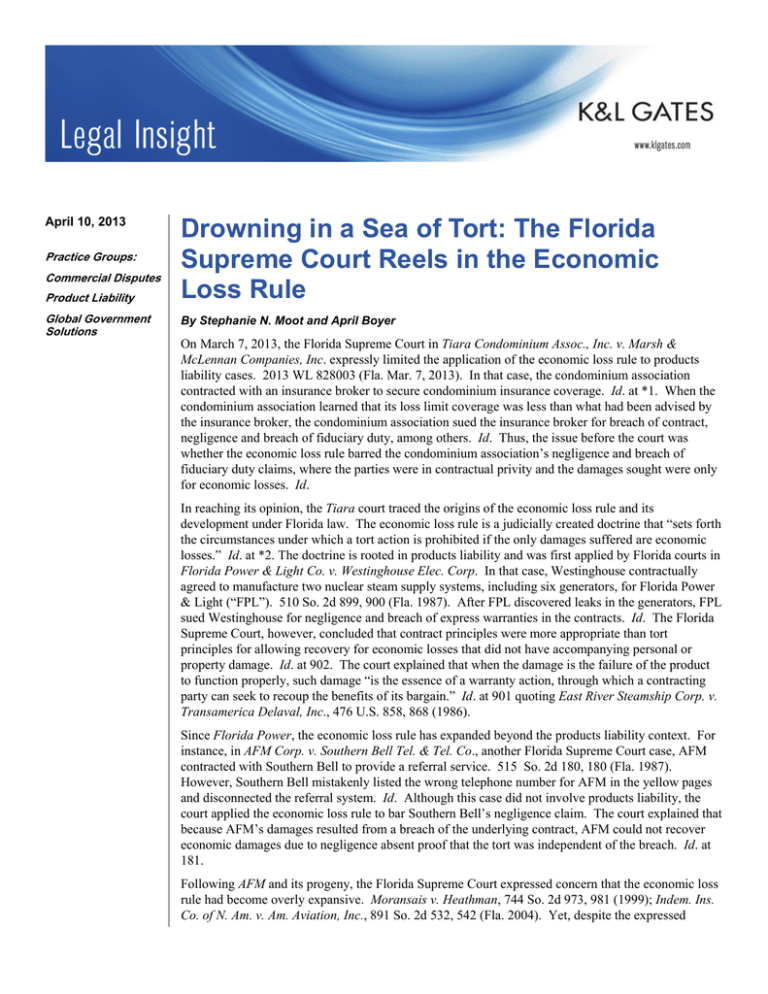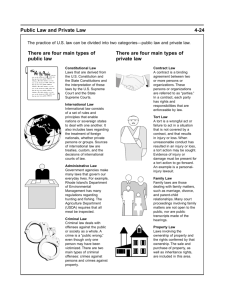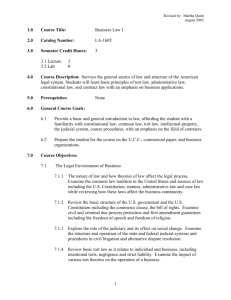
April 10, 2013
Practice Groups:
Commercial Disputes
Product Liability
Global Government
Solutions
Drowning in a Sea of Tort: The Florida
Supreme Court Reels in the Economic
Loss Rule
By Stephanie N. Moot and April Boyer
On March 7, 2013, the Florida Supreme Court in Tiara Condominium Assoc., Inc. v. Marsh &
McLennan Companies, Inc. expressly limited the application of the economic loss rule to products
liability cases. 2013 WL 828003 (Fla. Mar. 7, 2013). In that case, the condominium association
contracted with an insurance broker to secure condominium insurance coverage. Id. at *1. When the
condominium association learned that its loss limit coverage was less than what had been advised by
the insurance broker, the condominium association sued the insurance broker for breach of contract,
negligence and breach of fiduciary duty, among others. Id. Thus, the issue before the court was
whether the economic loss rule barred the condominium association’s negligence and breach of
fiduciary duty claims, where the parties were in contractual privity and the damages sought were only
for economic losses. Id.
In reaching its opinion, the Tiara court traced the origins of the economic loss rule and its
development under Florida law. The economic loss rule is a judicially created doctrine that “sets forth
the circumstances under which a tort action is prohibited if the only damages suffered are economic
losses.” Id. at *2. The doctrine is rooted in products liability and was first applied by Florida courts in
Florida Power & Light Co. v. Westinghouse Elec. Corp. In that case, Westinghouse contractually
agreed to manufacture two nuclear steam supply systems, including six generators, for Florida Power
& Light (“FPL”). 510 So. 2d 899, 900 (Fla. 1987). After FPL discovered leaks in the generators, FPL
sued Westinghouse for negligence and breach of express warranties in the contracts. Id. The Florida
Supreme Court, however, concluded that contract principles were more appropriate than tort
principles for allowing recovery for economic losses that did not have accompanying personal or
property damage. Id. at 902. The court explained that when the damage is the failure of the product
to function properly, such damage “is the essence of a warranty action, through which a contracting
party can seek to recoup the benefits of its bargain.” Id. at 901 quoting East River Steamship Corp. v.
Transamerica Delaval, Inc., 476 U.S. 858, 868 (1986).
Since Florida Power, the economic loss rule has expanded beyond the products liability context. For
instance, in AFM Corp. v. Southern Bell Tel. & Tel. Co., another Florida Supreme Court case, AFM
contracted with Southern Bell to provide a referral service. 515 So. 2d 180, 180 (Fla. 1987).
However, Southern Bell mistakenly listed the wrong telephone number for AFM in the yellow pages
and disconnected the referral system. Id. Although this case did not involve products liability, the
court applied the economic loss rule to bar Southern Bell’s negligence claim. The court explained that
because AFM’s damages resulted from a breach of the underlying contract, AFM could not recover
economic damages due to negligence absent proof that the tort was independent of the breach. Id. at
181.
Following AFM and its progeny, the Florida Supreme Court expressed concern that the economic loss
rule had become overly expansive. Moransais v. Heathman, 744 So. 2d 973, 981 (1999); Indem. Ins.
Co. of N. Am. v. Am. Aviation, Inc., 891 So. 2d 532, 542 (Fla. 2004). Yet, despite the expressed
Drowning in a Sea of Tort: The Florida Supreme Court
Reels in the Economic Loss Rule
concern, the Florida Supreme Court kept intact the extension of the rule with limited exceptions, such
as professional malpractice,1 fraudulent inducement,2 and negligent misrepresentation.3 American
Aviation, 891 So. 2d at 543. As such, the economic loss rule continued to be employed in nonproducts liability cases, unless an exception applied.
Concluding that it “simply did not go far enough” in reining in the “unprincipled extension” of the
rule, the Tiara court expressly held that “the economic loss rule applies only in the products liability
context” and receded from “prior rulings to the extent that they have applied the economic loss rule to
cases other than products liability.” Tiara, 2013 WL 828003, at *7. Thus, the court specifically
limited the application of the economic loss rule to products liability and did away with the exceptions
created over the last twenty-six years. Id. Given the newly limited application of the rule, the court
determined that the economic loss rule did not foreclose the condominium association’s tort claims
against the insurance broker. Id. at *8.
In light of the Tiara opinion, it appears that the framework of the economic loss rule has changed from
“the economic loss rule bars a tort claim arising from a breach of contract, unless an exception
applies” to “the economic loss rule only applies to products liability cases.” Thus, it seems that
litigants now “face the prospect of every breach of contract claim being accompanied by a tort claim.”
Id. at *14 (J. Canady, dissenting). This is significant because it increases a litigant’s exposure to
liability in a case that, before Tiara, may have been considered a simple breach of contract action.
Besides the increased cost of litigating a tort claim, a litigant may also be exposed to punitive
damages, which are generally available for a tort claim, but generally unavailable for a breach of
contract claim. Therefore, while the economic loss rule has been reeled in, we can expect to see a
boatload of contract actions “drowning in a sea of tort.” Id. at *13 (J. Canady, dissenting) (noting that
the economic loss rule was specifically designed to prevent contract actions from drowning in a sea of
tort).
Authors:
Stephanie N. Moot
stephanie.moot@klgates.com
+1.305.539.3373
April Boyer
april.boyer@klgates.com
+1.305.539.3380
Anchorage Austin Beijing Berlin Boston Brisbane Brussels Charleston Charlotte Chicago Dallas Doha Dubai Fort Worth Frankfurt
Harrisburg Hong Kong Houston London Los Angeles Melbourne Miami Milan Moscow Newark New York Orange County Palo Alto Paris
Perth Pittsburgh Portland Raleigh Research Triangle Park San Diego San Francisco São Paulo Seattle Seoul Shanghai Singapore Spokane
Sydney Taipei Tokyo Warsaw Washington, D.C. Wilmington
1
Moransais, 744 So. 2d at 983.
HTP, Ltd. v. Lineas Aereas Costarricenses, S.A., 685 So. 2d 1238 (Fla. 1996).
3
PK Ventures, Inc. v. Raymond James & Assoc., 690 So. 2d 1296 (Fla. 1997).
2
2
Drowning in a Sea of Tort: The Florida Supreme Court
Reels in the Economic Loss Rule
K&L Gates practices out of 48 fully integrated offices located in the United States, Asia, Australia, Europe, the
Middle East and South America and represents leading global corporations, growth and middle-market companies,
capital markets participants and entrepreneurs in every major industry group as well as public sector entities,
educational institutions, philanthropic organizations and individuals. For more information about K&L Gates or its
locations, practices and registrations, visit www.klgates.com.
This publication is for informational purposes and does not contain or convey legal advice. The information herein should not be used or relied upon in
regard to any particular facts or circumstances without first consulting a lawyer.
©2013 K&L Gates LLP. All Rights Reserved.
3








